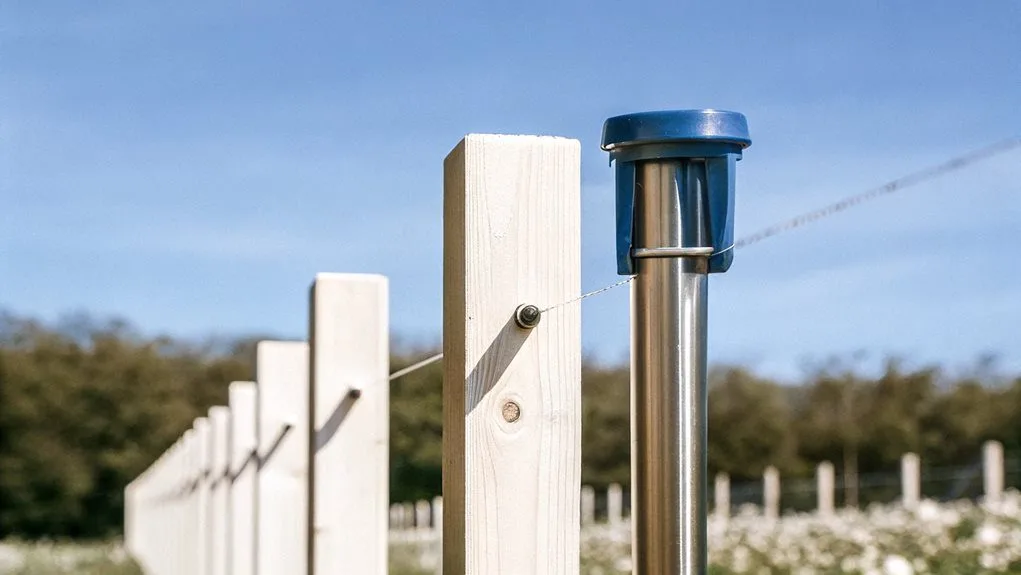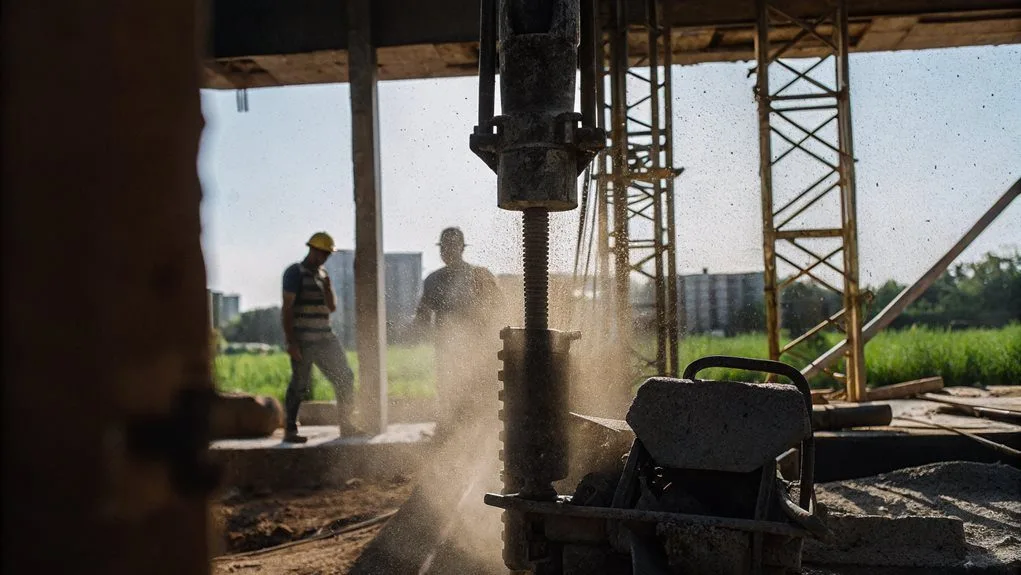So, when do you really need a construction roller? Well, unless you want your driveway to resemble the surface of the moon, you’ll want one to flatten that messy dirt. Rollers convert bumpy soil into smooth, compact surfaces that are essential for proper foundation work and landscaping projects.
Got clay or gravel? Different rollers work best for each type—like sheepsfoot for tough stuff. Just remember, it’s not a DIY rodeo; safety and costs matter too. Choosing the right roller depends on your specific project requirements and soil conditions.
Key Takeaways
- Use construction rollers when compacting soil for foundations to prevent settling and ensure structural integrity.
- Employ rollers to achieve a smooth, level surface for paving roads or installing tarmac.
- Consider rollers for increasing load-bearing capacity in projects involving heavy materials.
- Utilize vibratory rollers for effectively compacting granular soils like sand and gravel in construction.
- Rent or buy rollers based on project scale, frequency of use, and cost-effectiveness evaluations.
Understanding the Types of Rollers Available
When you think about construction rollers, you might imagine giant machines crushing dirt into submission. But let’s face it; they’re not just beefy toys for grown-ups.
From cylindrical rollers you can push around to ride-on pneumatic ones with rubber tyres, there’s a whole buffet of options. Need to flatten asphalt? You’ll want a smooth wheeled roller. Tackling tough soils? A sheepsfoot roller‘s your best mate, digging in like it owns the place.
And don’t forget the grid rollers, which are basically the heavyweights, crushing coarse materials with impressive pressure. Vibratory rollers are also versatile and known for their ability to enhance compaction on granular bases and asphaltic concrete. Additionally, smooth drum rollers are frequently employed in road construction to achieve effective surface compaction.
Each roller has its own quirks and best uses, so in this chaotic construction world, picking the right roller is vital. After all, you don’t want to crush your project dreams!
Key Applications of Rollers in Construction
Rollers are the unsung heroes of construction projects, converting chaotic piles of dirt into something that resembles a smooth road—or at least a solid foundation.
Rollers transform messy dirt into smooth surfaces, creating the solid foundations essential for successful construction projects.
You mightn’t think about it, but without rollers, your construction site could quickly turn into a mud pit.
Who wants that?
These machines compact everything from soil to tarmac, giving you a durable surface that won’t crumble beneath your feet.
Plus, they help increase load-bearing capacity, meaning your project can actually support the weight it needs to. The global road rollers market alone was projected to reach USD 7.1 billion by 2033, indicating the vital role these machines play in modern construction. In fact, the market was valued at USD 4.2 billion in 2022, highlighting the significant demand for these essential machines.
Road construction alone made up a whopping 35.1% of the roller market in 2022!
Choosing the Right Roller for Specific Soil Types
So, you think picking the right roller is a walk in the park? If only!
You’ve got to analyze soil composition, match it with roller compatibility, and let’s not forget the art of effective compaction. Vibratory rollers are particularly valuable as they compact soil, asphalt, and concrete by vibrating to fill empty spaces, preventing structural warping and sinking in buildings. Choosing a roller based on soil type and compaction requirements can significantly enhance project outcomes.
Good luck figuring that out without a cheat sheet!
Soil Composition Analysis
Ever wondered how on earth you’re supposed to choose the right roller for your project? You’re not alone. It can feel like trying to solve a Rubik’s Cube blindfolded. First, check your soil type. Granular soils like sand and gravel? Go for vibratory rollers—they vibrate like they’re excited to compact your life. Got clay or silty soils? Trench rollers are your best friend, bringing a punch of impact force to the party. And don’t forget about moisture; too wet or too dry can muddy your compaction plans. Just think, if you’re feeling lost, you’re probably in good company. Roller selection doesn’t have to be rocket science—or does it? Padfoot rollers are specialized for compacting cohesive soils, making them essential for your critical infrastructure projects. Cohesive soils are best compacted by impact force, ensuring your project stands on solid ground. Welcome to the wonderful world of soil composition analysis!
Roller Compatibility Factors
How do you figure out which roller fits your soil like a glove? Well, it’s not rocket science, but you wouldn’t want to pick a sheepsfoot roller for your tarmac, right?
Smooth drum rollers sleekly handle granular materials, whilst padfoot rollers plunge deep into cohesive soils like clay.
And let’s be honest, if your soil’s more like pudding, those elephantsfoot rollers, with their fewer, wider lugs, are your best mates.
Don’t forget the tandem rollers for tarmac; they come with twice the drum fun.
But hey, think about weight and size, too! You wouldn’t want a massive roller stuck in a muddy trench.
Choose wisely; your project—and maybe your sanity—depends on it!
Effective Compaction Techniques
When you’re knee-deep in soil, how do you know which roller to utilise? Well, if you’re dealing with sandy or gravelly material, grab a smooth or grid roller. They vibrate intensely — perfect for those loose particles!
But if clay’s your challenge, you’ll want a padfoot or rammer. It’s all about breaking that sticky soil bond.
Think about it: intense vibration for one, slow, powerful impacts for the other. You wouldn’t wear flip-flops during a Cape Town winter, right?
And remember, moisture levels matter. Too dry? You won’t compact properly.
The Role of Rollers in Ensuring Structural Integrity
Rollers play a starring role in ensuring structural integrity, though you mightn’t think about them whilst sipping your morning coffee. But let’s be real—without proper compaction, your dream project risks collapsing faster than your diet plans.
Vibratory rollers create that all-important uniform density, so your building won’t settle into an awkward slouch. No one wants a foundation that sings, “we’re sinking!”
And those grid and pneumatic rollers? They’re like the versatile friends we all need—effective for different soil types. You want your house to last, right? Nothing’s worse than crumbling walls because you skipped roller use.
Cost and Equipment Considerations for Roller Hire
When you’re thinking about renting a roller, let’s face it, your wallet’s about to take a hit.
Daily rates can soar from $50 for a tiny walk-behind to over $300 for something you might actually sit on—yikes!
And don’t forget about those pesky operating expenses; fuel and maintenance can sneak up on you like that surprise bill you simply hate to see.
Equipment Cost Analysis
Whether you’re tackling a quick job or delving into a lengthy project, figuring out equipment costs can feel like playing a game of hide-and-seek with your budget.
Should you buy that shiny R27 million roller or rent one for a month?
Sure, renting could only set you back around R3,500 to R5,200, but what if you’re knee-deep in a project that drags on?
Suddenly, those fees add up!
And what’s that? Size matters?
Yep, the bigger the roller, the bigger the price tag.
If only they came with a magical “cost-effective” button!
So, ask yourself: Are you really going to use that heavy piece of machinery enough to justify the purchase?
If not, renting might just save your sanity.
Operating Expense Factors
Operating a construction roller can feel like balancing on a tightrope.
You’ve got to juggle ownership costs—ever heard of depreciation?
Yeah, that’ll bite.
Then there are the operating costs: fuel, filters, and repairs.
And let’s not forget the tyres—they wear out faster than your gym shoes!
You’re looking at about R513 per hour, not counting labour.
Sound fun?
Think again.
Tack on insurance and taxes, and suddenly your wallet gasps for air.
Short-term rentals might tempt you, but will they save you?
If you use it a lot, fixed costs might actually get lighter.
Environmental and Safety Factors When Using Rollers
Construction rollers can feel like your noisy neighbour who just won’t quit, right? But let’s be real: they’re not just annoying; they can impact the environment too.
Electric rollers cut down on emissions, which is brilliant unless you’re stuck listening to one rumble past your house.
And don’t forget about construction waste—sustainable practises really do make a difference.
Now, whilst the vibrations from these machines could shake your sandwich off the picnic table, proper planning can minimise that.
Plus, you’ve got to think about worker safety. Proper training means fewer accidents, and that’s a win for everyone involved. So, yeah, those rollers might seem like a nuisance, but they can be your best ally when used right!
Conclusion
So, you’ve reached the end of your roller coaster ride—pun intended. It’s clear that knowing when to rent a roller is no walk in the park. Whether it’s for that upcoming driveway or a massive construction site, skipping on the right roller could leave you with a bumpy future. Do you really want to be the one who learns the hard way? Take the plunge and choose wisely—or you might just be rolling in regret.






